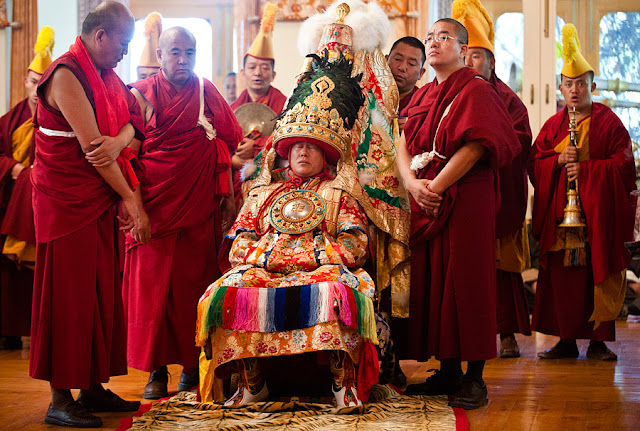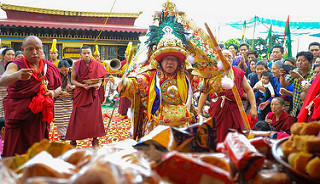Vajrakilaya, or Kila, means something sharp, and something that pierces – a dagger. A dagger that is so sharp it can pierce anything, while at the same time nothing can pierce it. That is the quality. This sharp and piercing energy is what is used to practice and out of the many infinites, endless Vajrayana methods this happens to be one of the most important methods.”
Vajrakilaya has 3 heads, 6 arms, and 4 legs. In his upper right hands he holds 2 Vajras (weapons), and in his middle left hand a trident-tipped khatvanga power-scepter. Vajrakilaya holds his symbol – the Phurbu dagger in his lower right and left hands. Despite the large fangs and bulging eyes and his wrathful appearance,Vajrakilaya is perceived as having a benevolent demeanor.
Vajrakilaya (enlightened activity) The deity representing enlightened activity is Vajrakilaya. In peaceful form, he is Vajrasattva, in semi-wrathful form he is Vajravidarana (Tibetan word is Dorje Namjom), in wrathful form he is Vajrapani, and in extremely wrathful form he is Vajrakilaya. Vajrakilaya in Vajrayana Buddhism is considered to be one of the most potent mantras to dissolve the obstacles in your life.
The practice can help to remove inner fear, cut self-clinging, and also help understand and realize the nature of the mind.It's said that the mantra shouldn't be recited loudly and openly due to the power of the mantra could post threats and causing a great sufferings and inflict harm, pain, or misery to the worldly spirits.
Vajrakilaya is a significant Vajrayana deity who transmutes and transcends obstacles and obscurations. Vajrakila is the divine form that governs the Kila. Guru Rinpoche, Padmasambhava achieved realization through practicing ‘Yangdag Heruka‘ but he first practiced Vajrakilaya to clean and clear obstacles and obscurations.
In the biography of Guru Rinpoche, Padmasambhava it is recorded that he travelled to the northern land of Kashakamala, where the cult of the Kila prevailed. Later, whilst meditating on the deity Yangdak Heruka in the ‘Asura Cave’ at Parping in the Kathmandu valley, he experienced many obstructions from the Maras, and in order to subjugate them he requests the Kila Vitotama Tantras to be brought from India.
When Guru Rinpoche, Padmasambhava Having established and consecrated the very first Tibetan Buddhist Samye Monastery with the Vajrakilaya rituals, he tamed the local spirit protector, Pehar Gyalp, and bound him by oath to become the head of the entire hierarchy of Buddhist protective spirits. Pehar, later known as Dorje.
The first transmission that Padmasambhava gave to his twenty-five ‘heart disciples’, in order to eliminate the hindrances to the propagation of the Buddhadharma in Tibet, where the teachings of the Vajrakilaya Tantra. From its early Nyingma origins the practice of Vajrakilaya as a yidam deity with the power to cut through any obstructions was absorbed into all schools of Tibetan Buddhism.
Guru Rinpoche and his closest disciple Yeshé Tsogyal travelled all over Tibet and the Himalayas, and blessed and consecrated the entire land, especially: “the twenty snow mountains of Ngari, the twenty-one Sadhana places of Ü and Tsang, the twenty-five great pilgrimage places of Dokham, the three hidden lands, five ravines, three valleys and one region.”
Guru Padmasambhava made many prophecies about the future, and together with Yeshé Tsogyal concealed countless Terma teachings, in order to: prevent the destruction of the teachings of the secret Tantrayana; avoid corruption of the Vajrayana or its alteration by intellectuals; preserve the blessing; and benefit future followers. For each of these Terma treasures, he predicted the time of its revelation, the identity of the Revealer, and those who would receive and hold the teachings.
A place called Tiger’s Lair, Taktsang in Bhutan, Guru Rinpoche manifested in “the terrifying wrathful form of crazy wisdom”, binding worldly spirits under oath to protect the Terma treasures and serve the Dharma. Then he was named Dorje Drolo, ‘Wild Wrathful Vajra’ and the fierce manifestation of Vajrakilaya (wrathful Vajrasattva).
In requesting and entering the *empowerment mandala of Vajrakilaya, you should set your motivation, first and foremost, as being not just for yourself, but in order to gain the capacity to liberate all sentient beings. Let your altruistic aspiration be the liberation of all sentient beings from their sufferings. The process is called empowerment, or initiation .
It is a key element to the practices of Vajrayana Buddhism. The initiation is necessary to practice. Just as perfume essences are grounded from various substances and made into oils, if they are not grounded and made into oils there will be no scent.
* Footnote
Please consult your Guru or a qualified lineage master for Vajrayana practice! Should a devotee even want to start studying and contemplating the Vajrayana practice, then it is truly necessary to first have completed the preliminaries and to be certain and sure that Bodhicitta has arisen and developed in one’s mind.
Vajrayana features countless skillful and powerful methods which, if they are practiced in the proper way, can make the process of accumulation and purification incredibly swift and direct. It is absolutely necessary to have the pure motivation and to know that Vajrayana practice is not carried out to increase one’s own ego, power and profit.
Do you earnestly cherish our devoted work? Assuming this is the case, we are delighted that you are finding our blog useful and valuable. Would you consider making a donation for our Buddhist research and development?
We need your help to secure the future of scholarly interaction with Buddhism. Since our very first publication of Dharma works and activities in the year 2008, we had been effortlessly providing free distribution of Dharma posts and articles throughout the previous 10 years. We have exceptionally constrained supports and do not receive subsidized or funding from people in general.
Please help us and to develop our Dharma activities that will not only benefit you, but to all Dharma readers on the planet. Please consider showing your support. Your generosity will certainly help us.
We need your help to secure the future of scholarly interaction with Buddhism. Since our very first publication of Dharma works and activities in the year 2008, we had been effortlessly providing free distribution of Dharma posts and articles throughout the previous 10 years. We have exceptionally constrained supports and do not receive subsidized or funding from people in general.
Please help us and to develop our Dharma activities that will not only benefit you, but to all Dharma readers on the planet. Please consider showing your support. Your generosity will certainly help us.
Thank you for reading, may you find peace and great bliss. With your support it helps to spread the Buddha’s precious teachings and turning the Dharma wheels in the world.
Aspiration For Bodhichitta
For those in whom the precious Bodhichitta has not arisen
May it arise and not decrease
But increase further and further.
Dedication of Merit
By this merit may we obtain omniscience then.
Having defeated the enemies wrong-doings.
May we liberate migrators from the ocean of existence.
With its stormy waves of birth, old age, sickness and death.
*Note
I do not own or infringe any copyright of the picture(s).
Picture(s) courtesy and credit to the rightful distributors and or studios.
Picture(s) is/are intended for editorial use only.
I do not own or infringe any copyright of the picture(s).
Picture(s) courtesy and credit to the rightful distributors and or studios.
Picture(s) is/are intended for editorial use only.





































